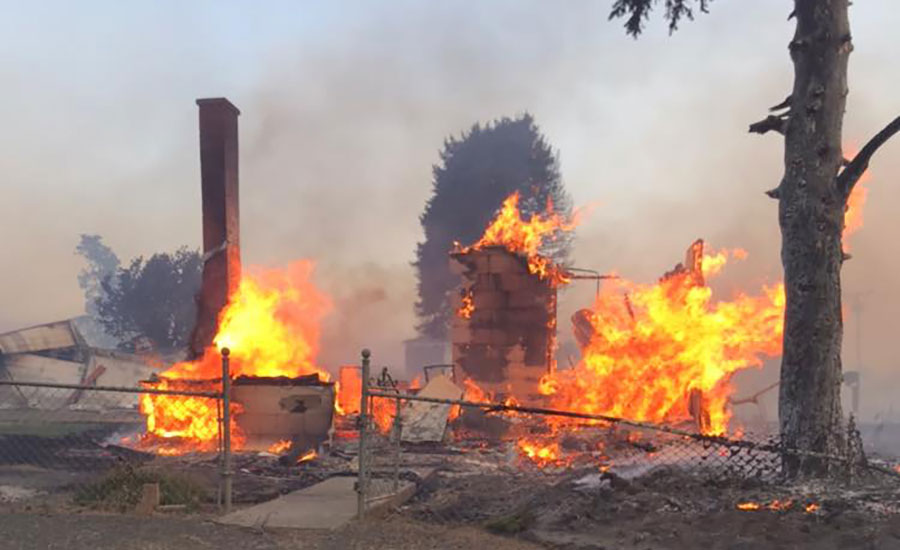After a devastating start to the week, fires continued to burn on Sept. 9 in Washington and Oregon. Extremely dry and gusty wind conditions sparked over 80 new fires in Oregon and Washington, including a dozen large-scale blazes and one that destroyed about 80% of Malden, Wash., a small town about 30 miles south of Spokane, Wash.
Meanwhile, Oregon’s Marion and Jackson Counties are the hardest hit. The Santiam and Lionshead fires were the strongest, burning about 200,000 acres, but it was the Almeda fire that destroyed hundreds of homes and businesses through Phoenix, Ore., and Talent, Ore., and led to evacuation orders for 80,000 people as it entered Medford, near Oregon’s southern border with California. The fire burned into recreational areas of Medford.
“Wind continues to fuel the wildfires, with devastating consequences across Oregon,” Gov. Kate Brown said in a statement. “We’re in an unprecedented fire event.”
The Portland office of the National Weather Service said on Wednesday that conditions remain “favorable for rapid fire spread which may threaten life and property.”
On Sept. 7 late morning, high winds began pushing through the Pacific Northwest, causing “several new starts for significant growth and multiple evacuations,” according to the Northwest Interagency Coordination Center. Fires already burning in the region grew as winds pushed flames and grounded planes and helicopters used to combat the blazes.
“Today alone, almost 300,000 acres in Washington have burned,” Hilary Franz, Washington’s commissioner of Public Lands, tweeted on Sept. 7. “Thousands of homes are without power. Many families have had to evacuate their homes and many homes have been lost. We’re still seeing new fire starts in every corner of the state.”
While many of the fires are still under investigation, Franz says, historically, 90% of Washington wildfires are human caused. Josh Clark, fire meteorologist and operations scientist for the Washington State Dept. of Natural Resources tweeted: “Numerous homes and property destroy, 30K+ without power. Every one of these was 100% human-caused and therefore 100% preventable.”
The Malden fire started around 1:30 p.m. Sept. 7. Within an hour, the fire engulfed the town of just over 200, according to the Whitman County Sheriff’s Office, and destroyed about 80% of the town’s buildings thanks to winds of 45 mph pushing sparks through dry fields. Malden’s fire station, City Hall, post office, and library were destroyed. There were no reports of injuries.
“The scale of this disaster really can’t be expressed in words,” Brett Myers, Whitman County Sheriff, said in a statement. “The fire will be extinguished, but a community has been changed for a lifetime.”
Interstate 90 and Highway 2, the two main routes in eastern Washington, were both closed due to fires, smoke and blowing dust at points on Monday. Highway 2 remained closed on Sept. 8.
While eastern Washington was especially hard-hit by the fires, the central and even western parts of the state were not unscathed. As smoke from the fires filled the skies, a brush fire outside of Sumner, Wash. destroyed at least eight homes in Graham, Wash., 24 miles southeast of Tacoma.
Power outages stretched across Washington and Oregon—with 80,000 Puget Sound Energy customers losing electricity due to high winds knocking down lines.
Eastern Washington companies worked to keep up with service outages on Sept. 8, including 10,000 Inland Power customers out of power; 7,000 Avista customers, 5,000 Northern Lights customers and 3,000 Kootenai Electric customers.
“With the longstanding wind gusts, widespread damage throughout our service territory and continued inability to access our lines due to fire, our members should be prepared for prolonged outages ranging into Wednesday or Thursday,” according to an Inland Power statement.
Avista says it sent all available crews, along with 19 contract and 13 vegetation management crews to Washington and Idaho for the restoration effort and that the bulk of damage involved trees bringing down lines. “Avista’s system is currently operating under dry land mode, which is an approach that helps decrease the potential for wildfires and requires our teams to physically patrol certain rural and forested areas before the lines can be re-energized,” Avista said in a statement.
Portland General Electric temporarily shut off power for customers in the high-risk fire zone near Mount Hood, impacting about 4,000 customers. “We do this to protect lives and property during these wildfire conditions,” the company said in a statement.
The dry, warm weather combined with gusty winds also fueled fires in Oregon, whether small brush fires that threatened individual homes in the populated areas in and around Portland or with growing wildfires near Salem, Ore. that have prompted evacuation orders for small communities.
Warm weather and breezes are expected through Thursday, according to the National Weather Service, keeping wildfire conditions in place. Red Flag Warnings are set for the majority of the region and dry easterly winds will “boost significant fire potential,” says the Northwest Interagency Coordination Center, “through Wednesday west of the Cascades.”






Post a comment to this article
Report Abusive Comment